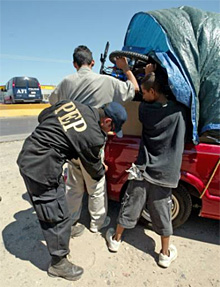 |
 |
 |
 News Around the Republic of Mexico | April 2007 News Around the Republic of Mexico | April 2007  
Drug War Turns Mexico Border City into Ghost Town
 Robin Emmott - Reuters Robin Emmott - Reuters


| | Once an easygoing Mexican border town thronging with U.S. tourists, Nuevo Laredo is becoming a ghost town because of a brutal, three-year-old turf war between rival drug cartels. (Reuters) |
Nuevo Laredo, Mexico - With heavily armed Mexican soldiers patrolling Nuevo Laredo's graffitied, rubbish-strewn streets, Mario Cepeda is having a tough time convincing anyone to take his horse-drawn city tour.

Once an easygoing Mexican border town thronging with U.S. tourists, Nuevo Laredo is becoming a ghost town because of a brutal, three-year-old turf war between rival drug cartels that has driven residents and businesses across the Rio Grande to the safety and prosperity of its Texan sister city, Laredo.

"Business is no good, nobody comes any more," said Cepeda in broken English as he waited in vain for passengers on Nuevo Laredo's main avenue, a few steps from the U.S.-Mexico border footbridge.

Almost 200 people were murdered in often gruesome, daylight shootings in Nuevo Laredo last year in a war between drug gangs from Mexico's western Sinaloa state and the local Gulf cartel that that killed around 2,000 people nationwide in 2006.

The violence has overwhelmed the shabby, low-rise city and destroyed its economy. It is in stark contrast to the freshly painted shops and tidy cobbled squares of Laredo, visible from Mexico through trees and wire fencing along the Rio Grande.

Jorge Ramirez, a local representative of President Felipe Calderon's National Action Party, says Nuevo Laredo is in a "coma" as 2,400 stores ranging from beauty salons to restaurants have shut down since 2004. Membership of the city's chamber of commerce has fallen 80 percent since a 2000 peak.

The 600 shops and stalls that remain open sell about a third of what they used to when U.S. tourists came in bus loads on day trips to buy Mexican craft goods like ponchos and hats.

"For Sale" signs, weeds and graffiti adorn empty mansions in the once wealthy Madero, Jardin and Mexico districts, where property prices have fallen by a quarter.

"The bars are all empty too," said Higinio Ibarra, head of the store owners' association in Nuevo Laredo's historic quarter, pointing to the shuttered La Mina bar, once a favorite of young Americans attracted by Mexico's lower drinking age.

"We used to get 60 bus loads of tourists a week. Now, not even one comes a month," he said.

SISTER CITY

Across the border in Laredo, where the economy grew 8 percent last year, construction workers are setting up a high-tech pedestrian border crossing with its own duty-free shopping center and sprucing up a pretty riverside park, as well as building hotels, luxury houses, hospitals and business parks.

Many residents of Nuevo Laredo have fled across the border, either legally or illegally, to the Mexican city's U.S. sister.

"I moved out last year, I don't want my children getting killed by a stray bullet. Besides, I'm earning three times more than I earned in Nuevo Laredo here in Laredo," said 40-year-old factory worker Jaime Salinas.

Part of Laredo's boom is directly related to Nuevo Laredo's demise, as Mexican companies move out of the city or choose Laredo over Nuevo Laredo for setting up new plants.

But few Laredo officials celebrate Nuevo Laredo's downfall. The two cities were once the same Spanish colonial settlement, San Agustin de Laredo, until an 1848 treaty ending the U.S.-Mexican war divided the two. The Hispanic community of Laredo is large and residents of both cities often have relatives just across the border.

TROOPS ON STREETS

Meanwhile, in Nuevo Laredo, Mexican soldiers sent by Calderon in January to calm the drug violence stop vehicles and quiz drivers, searching for weapons and narcotics.

"We cannot trust anyone, we are in a war zone," said one soldier, who declined to be named for fear of reprisals, in a helmet and black body armor.

Prompted by the jailing of local Gulf Cartel leader Osiel Cardenas in 2003, drug hit men from the western state of Sinaloa have used bazookas, rocket-propelled grenades and machine guns to try to muscle out the Gulf gang.

Despite a lull in violence since Mexican troops arrived, the cartels are still killing, intimidating and kidnapping journalists, police officers and business people to try to take control of Nuevo Laredo. Last month, cartel hit men seriously injured a Mexican lawmaker as he drove to the city's airport.

Victory for the Sinaloans would mean access to the Nuevo Laredo border crossing, one of the world's busiest trade routes.

Some 2.5 million trucks cross there every year, or 40 percent of U.S.-Mexican cross-border trade, making it a prime place to slip narcotics into the United States.

"This conflict is about greed. The Sinaloans want control of such a lucrative drug route," said John Johnson, assistant special agent in charge at the FBI in Texas.

The United States seized $12 million in cash between October 2005 and September 2006 along the Texas border.

Security officials say the Gulf cartel has fended off the Sinaloans but predict a new assault if the Mexican army hands security back to local police, some of whom are accused of working for the cartels. | 
 | |
 |



